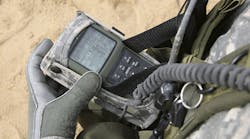Raytheon’s Miniaturized Airborne GPS Receiver 2000 (MAGR2K), recently demonstrated by the U.S. Air Force, is the first M-code receiver to be successfully tested in an avionics GPS receiver. Based on global-positioning-system (GPS) satellite signals, the new military-code (M-code) receivers exhibited enhanced position, navigation, and timing performance. The system integrates the latest anti-jamming, high-security capabilities of the advanced military signal.
The MAGR2K, based on a modular, open system architecture, provides 24-channel, all-in-view tracking, as well as reduced receiver channel switching between satellites. For the test, it was integrated with a Raytheon advanced digital antenna production (ADAP) system and equipped with a specialized M-code receiver card. It maintained GPS satellite and tracking, providing accurate navigation at jamming levels that surpassed expected technical requirements.
M-code evolved from the military’s P(Y) code and is transmitted in the same L1 and L2 frequencies. It is designed to be autonomous, unlike P(Y) code receivers that typically have to lock onto a civilian code before transferring to the secure network. Occupying 24 MHz of bandwidth, it’s intended to be broadcasted from a high-gain directional antenna as well as a wide angle, or full Earth, antenna. Use of a new packetized, rather than framed, military-navigation (MNAV) navigational message allows for more flexible data payloads.
